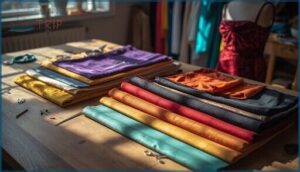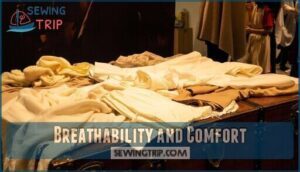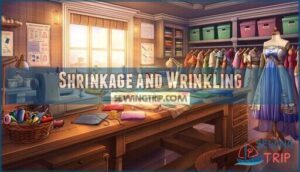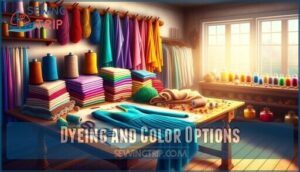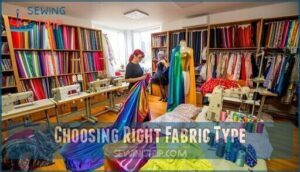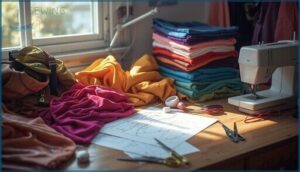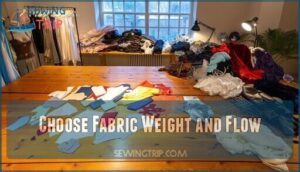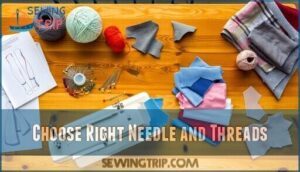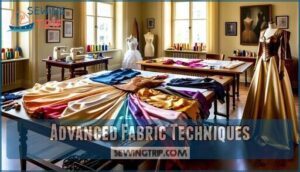This site is supported by our readers. We may earn a commission, at no cost to you, if you purchase through links.
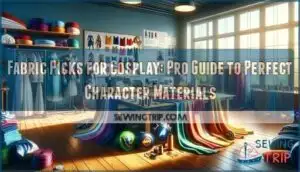
Natural fabrics like cotton and linen offer superior breathability for long convention days, while synthetics like spandex provide the stretch superhero suits demand.
Consider fabric weight—lightweight chiffon flows beautifully for magical characters, medium-weight cotton poplin structures school uniforms perfectly, and heavy canvas backs armor pieces effectively.
Test swatches for drape, stretch, and texture before committing to yards of material.
Don’t overlook practical factors like washability and how well fabrics accept dyes for precise color matching.
The right fabric transforms amateur attempts into professional-looking masterpieces that capture every character detail with stunning accuracy.
Table Of Contents
Key Takeaways
- Test before you buy – Always order fabric swatches to check drape, stretch, and texture before committing to full yardage, preventing costly mistakes and ensuring the material matches your character’s needs.
- Match fabric to character type – Use cotton for school uniforms and casual characters, spandex for superheroes needing stretch, velvet for fantasy royalty, and canvas for armor backing to achieve authentic looks.
- Consider weight and breathability – Choose lightweight fabrics like chiffon for flowing magical characters, medium-weight cotton poplin for structured garments, and prioritize natural fabrics for better airflow during long convention days.
- Master advanced techniques for tricky materials – Use walking feet for slippery fabrics like satin, heavy-duty needles for thick materials like leather, and always pre-wash to prevent shrinkage disasters in your finished costume.
Fabric Choice Matters
Your fabric choice directly impacts your cosplay’s authenticity, comfort, and overall success at conventions.
The right material can make your costume look professional and screen-accurate, while the wrong one can leave you sweating, uncomfortable, or looking like a budget knockoff.
Key Factors Affected by Fabric
Fabric selection drives your cosplay’s success through four critical factors.
Fabric durability determines whether your costume survives multiple conventions. Costume mobility depends on stretch and flexibility—spandex moves, canvas restricts.
Breathability tests reveal comfort levels during long wear sessions. Fabric weight and drape effects create authentic silhouettes that match your character’s look perfectly.
Choosing the right fabric type is vital, considering fabric drape issues to guarantee a realistic and comfortable costume, ensuring a perfect cosplay’s success.
Natural Vs Synthetic Fabrics
Understanding the divide between natural fabrics and synthetic fabrics starts with their origins and fabric properties.
Natural fabrics like cotton and wool come from plants or animals, offering superior breathability but higher material costs.
Synthetic fabrics emerge from chemical processes, delivering enhanced fabric durability at lower prices.
Blended fabrics combine both worlds through strategic fabric selection, balancing texture comparison benefits while reducing eco impact concerns for your cosplay projects.
Fabric Properties and Characteristics
Master your fabric selection by analyzing these core properties that directly impact your cosplay’s success:
- Fabric Density – Heavy canvas creates structure for armor, while lightweight chiffon flows for magical characters
- Texture Analysis – Smooth satin reflects light beautifully, rough burlap adds medieval authenticity
- Weave Patterns – Tight twill resists tears, loose knits stretch for superhero suits
- Fiber Blends – Cotton-poly mixes balance comfort with durability for long convention days
- Drape Effects – Stiff brocade holds royal shapes, fluid jersey clings naturally to your form
Natural Fabrics Explained
Natural fabrics offer distinct advantages that make them excellent choices for many cosplay projects.
You’ll find these materials breathe better than synthetics, accept dyes more readily, and provide authentic texture that enhances character accuracy, with natural fabrics being a key component.
Breathability and Comfort
Natural fabrics like cotton and linen offer superior breathability and comfort for extended cosplay wear.
Natural fibers breathe better than synthetics, keeping cosplayers comfortable during long convention days
Their Air Permeability allows moisture wicking and Thermal Regulation, keeping you cool during conventions. Skin Friendliness makes natural fabric for cosplay ideal for sensitive skin, while their Fabric Texture feels comfortable against your body all day long.
- Cotton provides excellent breathability for school uniform cosplays and casual characters
- Linen offers lightweight comfort perfect for historical or medieval costume designs
- Wool delivers natural temperature control for winter-themed or fantasy character outfits
Shrinkage and Wrinkling
Cotton, wool, and linen bring comfort but demand respect for their natural temperament.
Smart cosplay fabric selection means understanding shrinkage prevention and wrinkle resistance before your first stitch. Understanding fabric shrinkage rates is essential for choosing the right materials.
- Prewashing Importance – Always wash natural fabrics before cutting to prevent costume disasters
- Shrinkage Prevention – Use cold water and gentle cycles to maintain original dimensions
- Wrinkle Resistance – Fabric blends offer better wrinkle control than pure naturals
- Steaming Techniques – Steam iron works better than dry heat for delicate fibers
- Storage Smart – Hang finished pieces to minimize creasing between conventions
Dyeing and Color Options
Natural fabrics offer dyeing freedom that synthetic materials can’t match.
Cotton, linen, and wool absorb dyes beautifully, offering vibrant color theory applications and superior fabric dyeability.
You’ll achieve precise shade matching with various tint options and dye techniques.
However, watch for fabric bleeding during washing.
For superior results, understanding natural dye sources is essential to create unique and lasting colors.
| Natural Fiber | Best Dye Type | Color Fastness | Special Notes |
|---|---|---|---|
| Cotton | Reactive dyes | Excellent | Bright, lasting fabric colors |
| Wool | Acid dyes | Very good | Rich, deep fabric patterns |
| Silk | Acid dyes | Good | Luxurious sheen retention |
| Linen | Fiber-reactive | Excellent | Even color distribution |
Choosing Right Fabric Type
Selecting the right fabric transforms your cosplay from amateur to professional-quality results. Your fabric choice directly impacts comfort, accuracy, durability, and how well your costume photographs at conventions.
Character-Based Fabric Suggestions
Your fabric selection becomes your character’s voice, speaking volumes through every thread and texture.
Every thread you choose whispers your character’s story before you even step onto the convention floor.
Smart cosplay fabric choices transform good costumes into breathtaking character incarnations.
- Fantasy heroes: Linen for medieval authenticity, velvet for wizardly elegance
- Superheroes: Spandex delivers that second-skin effect with superior stretch
- School uniforms: Cotton poplin offers structure and easy handling
- Villains: PVC creates menacing shine and futuristic appeal
- Princesses: Satin provides lustrous flow for magical transformations
Where to Buy Fabrics Online
Smart shoppers know fabric selection success starts with choosing the right retailer.
Online stores like Mood Fabrics and Joann offer extensive costume fabric online selections with fabric swatches for testing. Digital marketplaces and wholesale websites provide bulk pricing, while coupon codes maximize savings during your fabric online shopping journey.
When searching for specific materials, considering cosplay fabric online options is essential for character-accurate costumes, and utilizing cosplay fabric sources can help achieve the desired look.
| Retailer Type | Best For |
|---|---|
| Specialty Stores (Mood, CosplayFabrics) | Character-accurate materials, premium quality |
| Wholesale Websites (Fabric Wholesale Direct) | Bulk orders, budget builds |
| Digital Marketplaces (AliExpress) | Experimental fabrics, tight budgets |
| Chain Stores (Joann) | Local pickup, Yaya Han cosplay line |
Working With Cosplay Fabrics
You’ve selected your fabric, but now comes the real test—making it work for your cosplay build.
Before you start cutting into that perfect material, you’ll need to understand how it behaves under your needle and whether it’ll give you the structure and movement your character demands.
Try Out Fabric Pieces
Before you commit to yards of fabric, testing small pieces saves both money and heartbreak.
Order fabric swatches online or request samples from stores to perform vital texture tests and weight checks.
Run your fingers across each sample, checking stretch and recovery. Drape analysis reveals how fabric falls—hold samples vertically to see natural flow.
This fabric sampling process prevents costly mistakes and guarantees your fabric picks align perfectly with your character vision. Considering the importance of fabric properties is essential for achieving the desired costume look and functionality.
Choose Fabric Weight and Flow
Beyond mere appearance, fabric weight and drape determine whether your cosplay moves naturally or looks stiff and lifeless.
Weight selection affects both comfort and authenticity—lighter fabrics create flowing movement while heavier materials provide structure.
Here are five key considerations for fabric weight and flow control:
- Lightweight fabrics (under 150 GSM) work best for capes, skirts, and ethereal characters
- Medium-weight fabrics (150-350 GSM) suit uniforms and fitted garments perfectly
- Heavy fabrics (350+ GSM) provide excellent garment structure for armor backing
- Fabric drape affects how naturally your costume moves during poses and walking
- Fabric stretch combined with proper weight creates authentic character silhouettes
Texture choice impacts visual accuracy—matching the original character’s fabric flow elevates your cosplay from amateur to professional-looking.
Choose Right Needle and Threads
Your needle selection directly impacts stitch quality and fabric compatibility.
Universal needles work for most cotton and polyester fabrics, while ballpoint needles prevent runs in knits.
Heavy fabrics like canvas require stronger needles to penetrate cleanly.
Thread selection matters too—polyester thread offers durability, while cotton thread suits natural fabrics.
Match your thread weight to fabric thickness for professional results.
Understanding the correct sewing machine needle types is essential for achieving the desired stitch quality.
Advanced Fabric Techniques
Once you’ve mastered basic sewing techniques, challenging fabrics like slippery satin and thick leather will test your skills in new ways.
These advanced materials require specific handling methods and tools to achieve professional results without costly mistakes, which is why understanding complete concepts is crucial.
Handling Slippery Fabrics
Working with slippery fabrics like satin, silk, and chiffon demands specific techniques for success.
Use pattern weights instead of pins to prevent shifting during cutting. Apply spray starch to washable materials for better fabric grip.
Install a walking foot on your machine to feed layers evenly. Place tissue paper under synthetic fabrics while sewing to prevent puckering.
Sharp microtex needles penetrate velvet and lycra cleanly without snags. Mastering satin fabric types is essential for achieving professional-looking cosplay costumes.
Sewing Thick Materials
When leather sewing becomes your next cosplay challenge, you’ll need the right arsenal.
Thick fabric demands heavy duty tools and strategic material selection for professional results.
- Heavy Duty Needles: Size 16-18 leather needles pierce without tearing
- Industrial Thread: Polyester or nylon handles stress better than cotton
- Walking Foot: Prevents fabric bunching on thick materials like canvas
- Sharp Rotary Cutter: Clean cuts through multiple fabric layers
These cosplay sewing tips transform intimidating thick fabrics into manageable projects.
Avoiding Common Fabric Mistakes
Since fabric mistakes can derail your entire project, smart fabric selection guide choices prevent costly disasters.
Pre-wash all materials to avoid fabric shrinkage and color bleeding that ruins finished costumes. Choose appropriate needles for thick fabrics to prevent fabric tears and seam failure.
Always finish raw edges to eliminate fraying issues. These costume fabric recommendations help fabric for cosplay beginners master their fabric choice decisions.
Understanding fabric cutting mistakes is essential for achieving professional-looking results in cosplay projects, and following these tips can help prevent costly disasters.
Frequently Asked Questions (FAQs)
What kind of fabric is used for cosplay?
You’ll use cotton and polyester for everyday characters, spandex for superheroes, velvet for fantasy royalty, and synthetic leather for futuristic designs.
Choose based on your character’s style and your sewing experience.
What is the best material for cosplay props?
EVA foam dominates cosplay props for its lightweight flexibility, easy cutting, and heat-shaping abilities.
Craft foam works for smaller details, while Worbla offers precision molding.
You’ll master professional-looking armor and weapons with these versatile materials.
What is the best fabric for a cosplay costume?
Cotton reigns supreme for beginners—breathable, forgiving, and budget-friendly.
Spandex delivers that superhero stretch you’re craving.
Choose based on your character’s vibe: velvet for royalty, canvas for armor, satin for magical transformations.
Where can I buy cosplay fabric?
Picture yourself standing before towering shelves of vibrant fabrics, each bolt promising your next cosplay masterpiece.
You’ll find quality materials at Joann Fabrics, Mood Fabrics, and Fabric.com online, plus local craft stores and thrift shops for budget-friendly treasures.
Do you need fabric for cosplay?
Yes, you’ll need fabric for most cosplay costumes.
Fabric forms the foundation of your outfit, determining how authentic and comfortable it looks and feels.
Choose materials that match your character’s style and your skill level.
What material should a cosplay costume be made out of?
Your costume material depends on your character’s design and your skill level.
Cotton works great for everyday characters, while spandex suits superheroes perfectly.
Velvet adds luxury for fantasy roles, and canvas provides structure for armor.
Is satin a good fabric for cosplay?
Nearly 40% of cosplayers struggle with satin’s slippery nature during construction, but you’ll create red carpet-worthy results when you master its precision demands and luxurious drape for princesses and magical characters.
What is the best fabric for a cosplayer?
There’s no single "best" fabric for cosplay since your choice depends on your character, skill level, and comfort needs.
Cotton works great for beginners and casual characters, while spandex suits superheroes perfectly.
What is the best material for cosplay?
While there’s no single "perfect" material, cotton reigns supreme for beginners.
It’s breathable, affordable, forgiving to sew, and works for most character types.
You’ll master techniques without fighting tricky fabrics first.
Is it cheaper to make or buy a cosplay?
Making cosplay typically costs less than buying, especially for simple designs.
You’ll spend $20-80 on materials versus $100-300+ for purchased costumes.
However, factor in your time investment and skill level when deciding.
Conclusion
Mastering fabric picks for cosplay transforms your costume from obvious homemade to convention-ready professional quality.
You’ve learned natural fabrics provide comfort during long wear sessions, while synthetics offer stretch and durability for action characters.
Weight matters—lightweight materials flow gracefully, medium weights structure garments properly, and heavy fabrics support armor effectively.
Test samples before purchasing full yardage to avoid costly mistakes.
With proper fabric selection and construction techniques, you’ll create authentic costumes that capture every character detail perfectly.
- https://fabricwholesaledirect.com/blogs/sewing-diy-tutorials/choosing-the-right-fabric-for-your-cosplay
- https://aliceincosplayland.com/2019/11/favourite-fabrics-for-cosplay.html
- https://www.moodfabrics.com/applications/costuming-cosplay-fabrics
- https://patternsbypatterncos.com/from-fabric-to-character-a-guide-to-choose-the-best-fabric-for-your-cosplay/
- https://icefabrics.com/blogs/news/best-fabric-for-costumes

